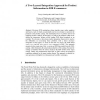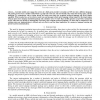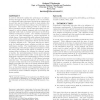45 search results - page 7 / 9 » Learning to Translate with Source and Target Syntax |
COLING
2000
13 years 8 months ago
2000
In the framework of statistical machine translation (SMT), correspondences between the words in the source and the target language are learned from bilingual corpora on the basis ...
ECWEB
2001
Springer
13 years 12 months ago
2001
Springer
Electronic B2B marketplaces bring together many online suppliers and buyers, each of which can potentially use his own format to represent the products in his product catalog. The ...
IJICTHD
2010
13 years 4 months ago
2010
Currently mobile users engage the services of a third party provider to translate an SMS text into a different language. The existing services have a number of drawbacks e.g. high ...
ACL
2008
13 years 8 months ago
2008
Word and n-gram posterior probabilities estimated on N-best hypotheses have been used to improve the performance of statistical machine translation (SMT) in a rescoring framework....
WOSP
2005
ACM
14 years 28 days ago
2005
ACM
In order to effectively validate the performance of software systems throughout their development cycle it is necessary to continuously build performance models from software mod...



